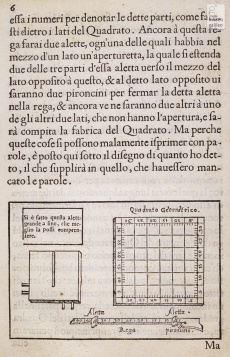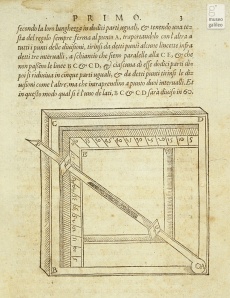Geometrical Square
From Inventions
Name adopted since the fifteenth century (in Latin quadratum geometricum), previously known as instrumentum gnomonicum.
Contents |
Inventor
Anonymous arab
Historic Period
10th-11th C.?
Description
Instrument for architectural and topographical measurements. Derived from the astrolabe, of which it reproduces only the shadow square, enlarged, divided into twelve parts per side, the geometrical square is designed exclusively for terrestrial measurements. In size it could be as large as two braccia per side (approx. 120 cm). At the angle opposite the one formed by the two shadows is hinged a vane with sights that simulates the inclination of the Sun's ray. Intersecting the front of the instrument, the vane marked the umbra versa cast by a hypothetical horizontal gnomon represented by the upper side. Intersecting the lower side instead, it indicated the umbra recta cast by a hypothetical vertical gnomon represented by the lower side. Given the relationship between shadows and gnomons, the instrument was sometimes called gnomon or gnomonic instrument (D. da Chivasso; L. Pacioli).
Bibliographical Resources
Domenico da Chivasso. The Practica Geometriae of Dominicus de Clavasio. Edited by H.L.L. Busard, «Archive for the history of exact sciences», 1 (1965), 7.
Pacioli, Luca. Summa de arithmetica, geometria, proportioni et proportionalità. Venezia, Paganino de' Paganini, 1494, VII, I.
Fibonacci, Leonardo La Pratica di Geometria. Volgarizzata da Cristofano di Gherardo di Dino cittadino Pisano, dal codice 2186 della Biblioteca Riccardiana di Firenze, a cura e con introduzione di Gino Arrighi. Pisa, Domus Galileiana, 1966, VII, p. 204.
Francesco di Giorgio Martini. La pratica di geometria: dal codice Ashburnham 361 della Biblioteca Medicea Laurenziana di Firenze. A cura di Gino Arrighi. Firenze, Giunti, 1970, c. 31r.
Peurbach, Georg. Quadratum geometricum praeclarissimi mathematici Georgii Burbachii. Nurenbergae, per Joannem Stuchs, 1516.
Finé, Oronce. La Composition et usage du quarré géométrique par lequel on peut mesurer fidèlement toutes longueurs, hauteurs et profunditez reduict nouvellement en françois, escrit et pourtraict. A Paris, chez Gilles Gourbin, 1556.
Boffito, Giuseppe. Gli strumenti della scienza e la scienza degli strumenti: con l'illustrazione della Tribuna di Galileo. Facsimili di Primo Benaglia. Firenze, Libr. internazionale Seeber, 1929.
Turner, Anthony. Early scientific instruments: Europe 1400-1800. London, Sotheby, 1987.
Kiely, Edmond R. Surveying instruments: their history. Columbus, Carben surveying reprints, 1979.
Jode, Cornelis. De quadrante geometrico libellus: in quo quidquid ad linearum et superficierum, utpote altitudinum et latitudinum, dimensiones facit lucidissime demonstratur, additae figurae aeneae 37. ad maiorem doctrinae intelligentiam et lucem hactenus non ita expositae. Noribergae, sumptibus et expensis Cornelii de Iudaeis editus, typis Christophori Lochneri, 1594.
Hultius, Levinus. Theoria et praxis quadrantis geometrici... das ist, Beschreibung, Unterricht und Gebrauch des gevierdten geometrischen und anderer Instrument. Noribergae, Typis Gerlachianis, sumptibus Cornelii de Iudaeis, 1594.
Hultius, Levinus. Tractatus primus [-tertius] instrumentorum mechanicorum Levini Hulsii, ocularis demonstratio novi geometrici instrumenti. Francofurti ad Moenum, ex Officina typogr. Wolfgangi Richteri, impensis autoris, 1605.
Metius, Adriaan. Arithmeticae et geometriae practica Adriani Metii. Franequerae, excudebat Rombertus Doyem, 1611.
Existing Instruments
- Museo Galileo, Institute and Museum of the History of Science, Florence
Florence, Museo Galileo. Institute and Museum of the History of Science, inv, 121.
Links (External)
http://catalogue.museogalileo.it/multimedia/GeometricalSquare.html (Italian)
http://wissensgeschichte.biblhertz.it:8080/Glossario/Glossario_Italiano/quadrato_geometrico/edit_main (Italian)
Images
Author of the entry: Filippo Camerota


